Tracking time: Whitewater Depot Museum offers historical journey
- Home
- Tracking time: Whitewater Depot Museum offers historical journey
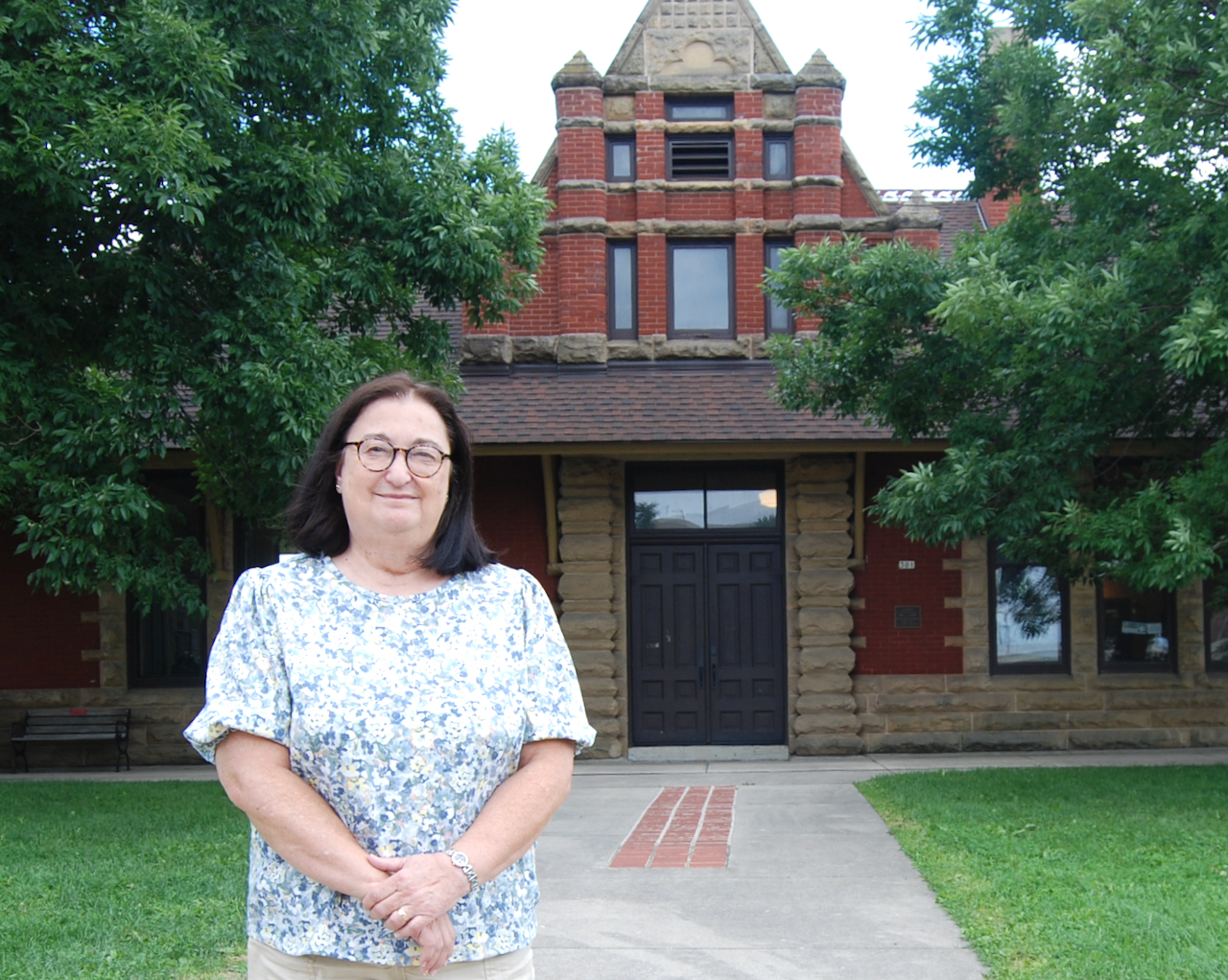
Tracking time: Whitewater Depot Museum offers historical journey
By Kim McDarison
A long time ago, before photography, cell phones and Facebook, people lived in Whitewater.
Carol Cartwright, president of the Whitewater Historical Society, along with myriad others, has been collecting evidence of early inhabitants and the many who followed, and society members have carefully preserved, cataloged and presented it in the city’s Depot Museum with a goal of promoting education.
Among treasures found in the museum is a collection of works by Henry Rile, a young man from New York, who, arriving in Whitewater in 1856, sketched and painted buildings and scenes in the community, offering some of the earliest glimpses of Whitewater as he sought adventure “in the ‘west,’” Cartwright said.
The museum’s building, a former train depot, is, itself, an antiquity and has a storied past, she noted.
Organizing artifacts and anecdotes for display is not an activity that has been relegated to the past, Cartwright said, noting that on Wednesday, the historical society will launch its redesigned website, which also will embrace an educational theme.
For Cartwright — who has enjoyed a 30-year career as a historical consultant, helping municipalities and organizations identify buildings within their communities for inclusion on state and national historical registries — a defining piece of Whitewater’s history begins with the depot.
‘Milwaukee Road’
While the depot has served as a museum since 1974, its history begins in 1890, which, Cartwright said, was the year construction began. The building opened as a depot for passenger use in 1891.
The passenger depot was the second built in the area by the railroad, she said, noting that an earlier, wooden structure occupied space adjacent to the museum, in what is today the municipal parking lot across the street from the Whitewater Municipal Building. The first depot was razed in 1990 as part of a renovation project to pave what was then a gravel lot.
According to Cartwright, the first trains came through Whitewater in 1852.
A lot of railroad companies organized in the 1840s, she said, but they never laid track.
The first company in Wisconsin to find the capital to begin the process was the Milwaukee and Mississippi Railroad company, and Whitewater became one of the first communities to become a stop along the route, which, in 1850, emanated from Milwaukee and moved west.
Plans to bring the railroad to Southeastern Wisconsin grew from a desire on the part of the railroad and area farmers to bring commodities such as wheat and produce to market.
In those days, other means of conveyance, such as roads, were “undeveloped,” Cartwright said. The railroad offered a more efficient way to move commodities.
The railroad wanted particularly to bring rail service to farmers in Walworth and Rock counties, she said, adding that, at the time, residents in Whitewater participated in fundraising efforts to bring the railroad to the community.
The railroad’s overall plan was to lay track between Milwaukee and Prairie du Chien — Lake Michigan to the Mississippi River — Cartwright said.
Following that plan, and beginning in Milwaukee, the company brought track to Waukesha, then Eagle, Palmyra, and Whitewater. The company next set sights on Milton, Janesville, and Madison, before reaching Prairie du Chien.
The first trains moving through the community carried both freight and passengers, and stopped at the wooden depot, which was built in 1852.
She described the former depot as a single-frame, approximately 1,200-square-foot building, which, she noted, is approximately the same size as the masonry building from which the museum operates today.
The wooden depot was used for both passengers and freight until the new building was opened in 1891.
In 1880, she said, patrons using the old wooden depot described its condition as “terrible,” and called for a new depot, and, Cartwright said, the railroad said, “sure.”
“They hired a young architect named J.T.W. Jennings, and gave him the freedom to design this building,” she said, adding that Jennings did not design a “cookie-cutter building” like others serving the railroad.
“He only served the railroad for one year, and then he became the architect used by the University of Wisconsin-Madison,” she said.
According to online sources, UW-Madison was founded in 1848, when Wisconsin achieved statehood.
Eventually, the Milwaukee and Mississippi Railroad company merged with a number of other railroad companies, becoming the Chicago/Milwaukee/St. Paul Railroad, which, Cartwright said, was commonly called “Milwaukee Road.”
After the second depot was built, the railroad operated two depots in Whitewater. The newly erected building was used for passengers, and the earlier build wooden structure was used for freight.
In 1952, passenger service in Whitewater ended and the railroad vacated its passenger depot. Freight service continued for approximately another 10 to 20 years, Cartwright said. By 1970, she added, “freight service in Whitewater was done.”
In the late 1950s, the former passenger depot found new life as a feed store.
According to Cartwright, the railroad leased the depot space to Walenton’s Feed and Garden Store, which operated between 1958 and 1970.
After the store closed, the building sat vacant again, she said, and by the early 1970s, Milwaukee Road was looking to sell it.
At the time, the historical society was looking for space. The society did not have a museum, but it had been assembling a collection, which was being stored in various locations throughout the community, Cartwright said.
“The city of Whitewater purchased the building in 1973 with the expectation that the historical society would be given a 99-year lease,” she added.
From depot to museum
When the city acquired the building, “it was pretty beat up,” Cartwright said.
Efforts were made to clean the space and a new roof was added. The inside of the building was painted.
Renovations, and fundraising efforts to support them, were overseen by the historical society. The initial efforts allowed the building to open as a museum in 1974, receiving visitors each summer for, Cartwright said, “a number of years.”
In 2012, she said, the society, in conjunction with the city, began a “major renovation” of the building. Some $400,000 was raised largely through a federal grant, but it came with a requirement that the community raise $80,000. The society and the city split the amount, with each contributing $40,000, Cartwright noted.
The partnership continues today to finance the museum’s maintenance and upkeep, with each entity — the historical society and the city — contributing 50% of those costs, she said.
During the renovations, Cartwright said: “We wanted to save as much of the character of the building as possible.”
While approximately 90% of the building’s accoutrements are original, some modern additions have been added.
“We have air conditioning,” Cartwright said.
Absent from the building are bathrooms that are accessible to the public.
The collection
According to Cartwright, members of the society began collecting historical items in 1946, which also was when the society officially formed.
By the time the museum opened, the society was in possession of “hundreds of items,” she said, ranging from antique furniture, and housewares, to photographs, tools and machinery.
She noted a large flywheel on display in the depot, which, she said, was saved from another old building in town. The wheel was turned by water to create power, she said. The device it powered remains a mystery, she added.
The collection also includes old maps, manuscripts, pamphlets and other “papers.”
As area residents brought items to the society, the collection formed, although today, Cartwright said, “We have such a small space that we don’t pursue or pay for items for the collection.”
The museum did make an exception to the rule, she said, when it acquired a collection of Whitewater pottery.
Realizing the items were “very rare,” historical society members acquired them at an auction, she said.
The group only collects things that are related to Whitewater, she added.
Most recently, the museum accepted a donation of quilts made by a Whitewater resident. The items were received a couple of weeks ago, Cartwright said, and likely will be included in an exhibit featuring quilts sometime in the near future.
Also found within the collection are several pieces of old clothing.
“We only display about 20% of our collection in the museum; it’s just too big for every piece to be on display at one time,” Cartwright said, noting that a section of the museum, called the “temporary” or “small” gallery, is used to cycle items within the collection onto the display floor. The display is updated annually, and usually follows a particular theme. The display in the temporary gallery this year features clothing.
Over the years, she said, the way in which the collection is displayed also has changed.
Prior to 2013, Cartwright said, the society worked to display as much of the collection as it could.
Arrangements of artifacts within the building were similar to those found in an antique store.
After the building was renovated, a decision was made to focus on education, and the space was divided into two galleries, Cartwright noted.
The remaining depot space, called the “large” gallery, exhibits more permanent displays, with artifacts arranged within a historical timeline and educational context.
Exhibits are arranged within nine distinct categories, beginning with “Pre-1836 Whitewater,” featuring artifacts and stories of Whitewater’s inhabitants before European settlers, and continuing through the “Post World War II Era, 1945,” featuring artifacts from the “varied businesses that served the community in the mid-20th century.”
“Our mission is to educate and not just be a storage facility for a bunch of old stuff,” Cartwright stated.
Also included in the collection are more than 4,000 images, most of which are photographs, and 90% of those are digitized, she said.
Many are not yet available to the public through display at the museum, but can be made available to those interested in research through appointment.
Visitors to the museum will find a self-guided tour, with each exhibit identified on an informational card.
Docents are available to answer questions.
Hours of operation
The museum, 301 Whitewater St., is open annually between the first day of May and the first day of November, Tuesdays, between 4 and 7 p.m., and Saturdays, between 9 a.m. and noon.
Hours are consistent with those of the Tuesday City Market and the Saturday Farmers Market, Cartwright said.
The museum also is made available to interested parties by appointment.
All visits to the museum are free of charge.
Cartwright noted that by Wednesday, the society’s website will begin sporting a new look.
“Our website is a redesign to make it easier for visitors to find things and for us to keep it updated in a more timely manner,” Cartwright said, further describing the redesign as user friendly and easy to navigate.
Visitors to the site will find historical photos and articles, and a small achieve, she said.
To learn more about the society and the museum, visit https://whitewaterhistoricalsociety.org.

Whitewater Historical Society President Carol Cartwright shares information about Whitewater as a “Maturing Village.” The display includes reproductions of sketches and watercolor paintings made in the mid- to late-1850s by Henry Rile, a young man from New York who arrived in Whitewater in search of adventure.
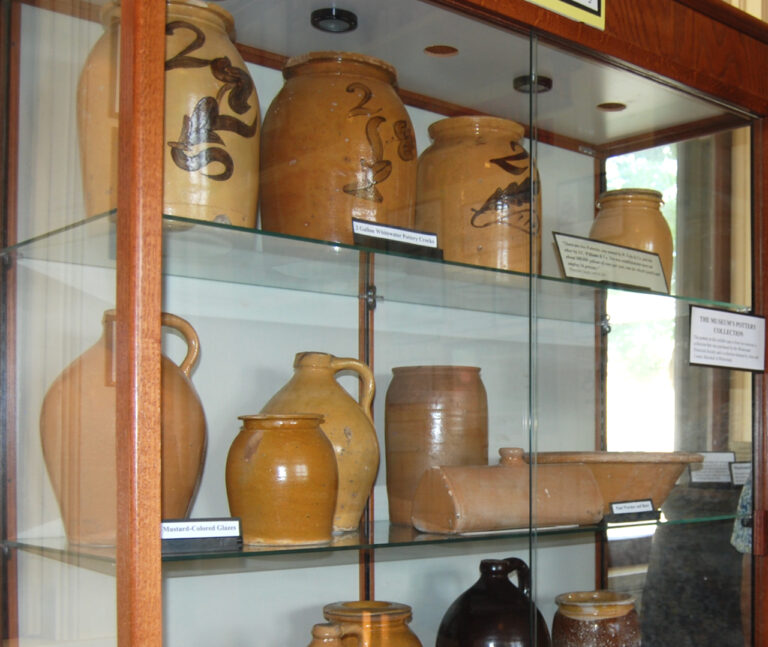
Whitewater pottery, collected through several sources, is among items on display in the large gallery of the Depot Museum.
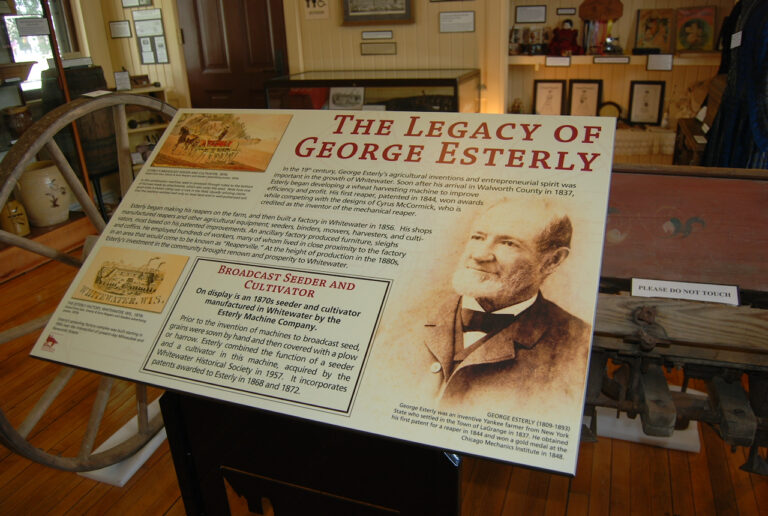
“The Legacy of George Esterly,” holds a prominent space in the museum’s large gallery. An inventor of agricultural machinery and entrepreneur, Esterly arrived in Whitewater in 1837 and is credited, according to the museum’s display, with facilitating some of the area’s earliest “renown and prosperity.”
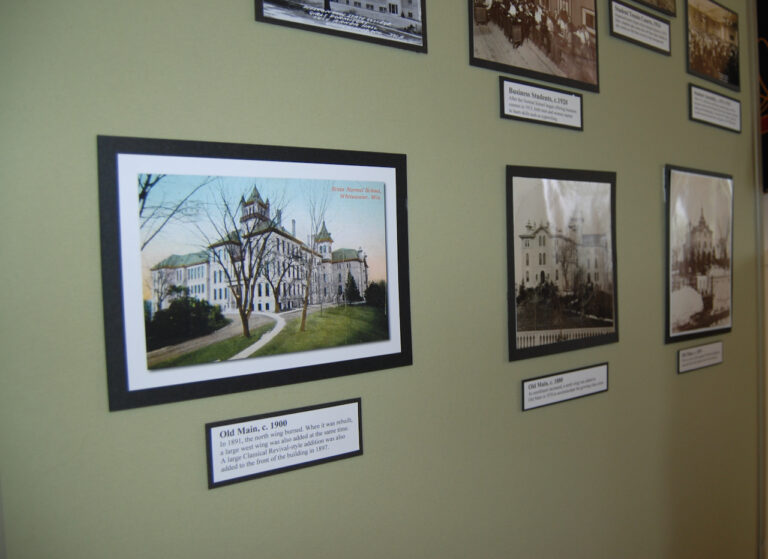
Images of the University of Wisconsin-Whitewater are among items on display. The full collection boasts some 4,000 images of Whitewater.
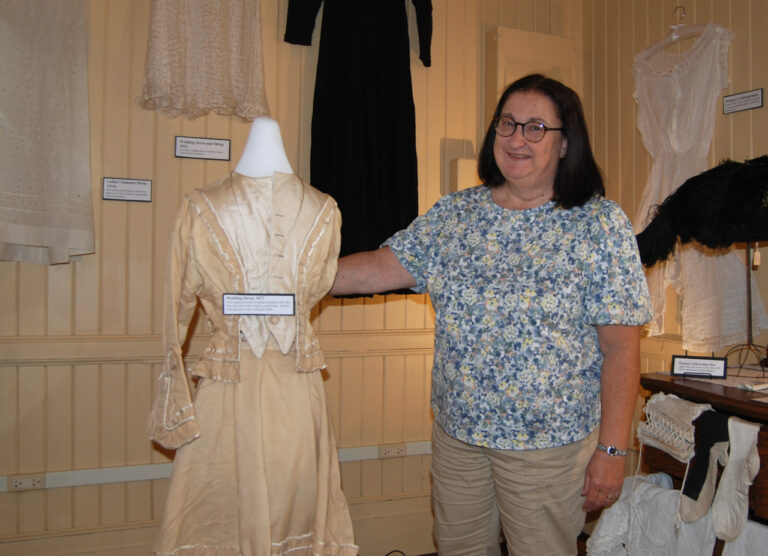
Whitewater Historical Society President Carol Cartwright presents a wedding dress from 1872. Available for viewing in the temporary gallery, this year’s theme is old-fashioned clothing.

Whitewater Historical Society President Carol Cartwright invites the public to visit the Whitewater Depot Museum. The building is open during warm-weather months on Tuesdays and Saturdays. The society has recently redesigned its website to better present historical information about the community and operational information about the museum. The new website is anticipated to become available by Wednesday.
Kim McDarison photos.
This post has already been read 1501 times!
Kim
One thought on “Tracking time: Whitewater Depot Museum offers historical journey ”
Leave a Reply Cancel reply
Our Advertisers
Most Read Posts
- Our Take: If secrecy is embraced, transparency is disabled
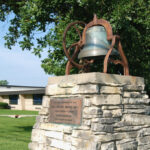
- Eight finalists make the cut in Whitewater WindUp competition; winner to be chosen May 18

- DOT: Two-phased improvement project slated for highways 11 and 12 in Walworth County
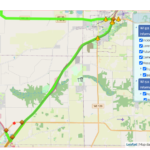
- Roundtable presenter shares affordable housing designs, cost-reducing construction options

- Commentary: Remembering journalist Sam Martino

- DOT: Department revokes three Elkhorn wholesale dealers' licenses

- BaristaCats Cafe takes first place in Whitewater WindUp competition

- UW-Whitewater May 2024 graduates receive degrees

- Food drive to support local pantries to be held Saturday

- CDA recommends approval of 128-unit multifamily development on Moraine View Parkway

Categories
- Advertisers
- Area events
- Art, culture
- Business
- Community
- County
- Crime, court
- Culture
- Diseases
- Economics
- Food
- Government
- International
- Law and Court
- Lifestyle
- Obituaries
- Opinion
- Police, fire, EMS
- Religion
- School
- Science
- Technology
- Today's features
- Today's news
- Top Stories
- Travel
- Uncategorized
- University
- World













Thank you for all your work in preserving Whitewater . I am 84 and was born in Whitewater at the Mary Sweet hospital .The building still stands at the counter of Main and Conger . My Ancestors lived down the street ,as did I in future years . That house is still there also .